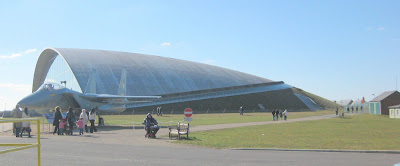Imperial War Museum Duxford.
Well worth a visit, but make sure you have plenty of time - at least all day or several days if you are really are keen on airplanes. Duxford has plenty to see, not only the static displays in the main display hangers, but there are several large older hangars where maintenance, overhaul and restoration work is going on. The techs working on the planes are friendly and only too pleased and proud to talk about their pet planes. And of course, we can't forget, he American Air Museum.
 Sunday the 7th March, I got up early for a long anticipated visit to the Duxford aircraft museum. I looked out the window - frost - went out to car and it was minus 4 degrees C. A bit cold for a old chap only recently arrived from summer in the South Pacific. Back inside and reading until 10 a.m. when the temperature had risen to zero but the sun was out and not a cloud in the sky. So off to the aircraft museum.
Sunday the 7th March, I got up early for a long anticipated visit to the Duxford aircraft museum. I looked out the window - frost - went out to car and it was minus 4 degrees C. A bit cold for a old chap only recently arrived from summer in the South Pacific. Back inside and reading until 10 a.m. when the temperature had risen to zero but the sun was out and not a cloud in the sky. So off to the aircraft museum.The first hangar was huge with a gallery walkway allowing you to look down at the aircraft on the floor and up to those suspended from the ceiling. Here the walkway can be seen in the background just above the Lancaster. Also there is a Vulcan, Sunderland, Lancastrian, Mosquito, Lysander, and few more.
In other hangars I found teams working on various aircraft. Here a team of enthusiasts and preparing a Fortress for the coming summer flying season. this plane was interestingly named Sally B on one side and Memphis Belle on the other.
And in another hangar these three guys had a problem doing something to a nut. Evidently they could only just just get their hand in to reached the nut, or what ever, and each time I passed them another one was having a go.
The next hangar I found this group working on a rebuild of this Bristol MKIV type 149 G-BPIV
"Spirit of Britain". Interesting story - it crashed in 1987 just 4 weeks after a 12 year rebuild. the second rebuild took 5 years.The plane flew many times until in 2003 it crashed again. Hence this rebuild. After talking with the restorers I was allowed to cross the rope boundary and have a look inside.
An auto-gyro,
and one for the Indiana Jones fans
- a Junkers Ju52/3m.
- a Junkers Ju52/3m.
Then off to the American Air Museum. A building specially designed to fit around the wingspan of the terrifying Boeing B-52 Stratofortress bomber. On the way passed several outside exhibits such as the German V1 rocket and launching ramp.
And as the IWM site says This outstanding example of contemporary British architecture .. .. houses the largest collection of American warbirds on display outside the United States, including a vintage B-17 Flying Fortress, B-24 Liberator, B-25 Mitchell, P-47 Thunderbolt, and aircraft from the Cold War era such as a B-52 Stratofortress, SR-71 Blackbird and F-4 Phantom, with many suspended from the ceiling as if in flight.
And when you walk in, onto a elevated gallery, you look right in the the cockpit if the Boeing B52 bomber.
While some as spend our time photographing aircraft some have a far simpler way.........
As my trip proceeds, I will be visiting the Battle of Britain Memorial Flight at Coningsby to see the Lancaster, Hurricanes and Spitfires. Later I will travel to The Shuttleworth Collection to see the pre-WWII planes and drive pass (and photograph) the R100 and R101 airship hangars just out of Bedford.
But more later......





























 In March this year I went to England primarily to see some of the early diaries associated with Scott's Last Expedition in the archives of the Scott Polar Research Institute, but while there I took the opportunity to visits several aircraft museums and other places of interest.
In March this year I went to England primarily to see some of the early diaries associated with Scott's Last Expedition in the archives of the Scott Polar Research Institute, but while there I took the opportunity to visits several aircraft museums and other places of interest.
